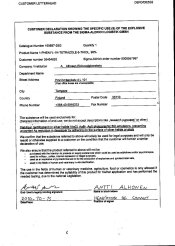Ryuji - Does Fischer mention the mechanism that cadmium or mercury used when these species were used as stabilizers? And when he says stabilizer, does he mean that it keeps the product from fogging - ie. it stops the action of sulfur speed enhancement?
The mechanism is where problem begins. Fischer lumps divalent metals in one short section on p. 138, where he gives reference to James 4th edition for the mechanism, but then James 4th edition gives reference to Mueller and Spracklen for mercury and Ranter for Au, Pt, Ir salts. They all point toward oxidation of metallic silver specks, and while that may be true in some cases, I have rather difficult time believing that is the mechanism, at least for manganese.
First of all, if the oxidizing power is so significant, why gelatin doesn't interact with the metal salt much faster? Gelatin contains some reducing components, such as sugars, methionine, cystine, aldehydes, etc. Since 1980s oxidized gelatin was introduced to emulsion making, but adding manganese to the kettle is a lot cheaper solution if that was adequate. (Caveat: one main motivation of using oxidized gelatin was tabular grain, and for that matter, adding manganese in the kettle can be a bad idea, as it may affect the crystal habit.)
Also, if the oxidizing power is significant enough to bleach the reduction fog centers, why isn't manganese used often in gold sensitized emulsions? (Gold sensitized emulsions are very sensitive to reduction fog centers and that's probably one of the three most probable reasons for why gold sensitization can be difficult.) In reality, use of a mild but rapid acting oxidizing agents is frequently contemplated and probably used in practice to produce very low fog emulsions.
Well, I'll have to read what Mueller and Spracklen found before making my opinion on this matter.
Generally, the behavior of metal salt/complex dopants/sensitizers/stabilizers is not very straight forward because there are many mechanisms in action. For one thing, they can adsorb on AgX surface and affect the ripening rate (can accelerate or retard, sometime one agent can do both), influence on the interstitial silver ion level, influence on the electron lifetime via electron trap mechanisms, influence on the crystal habit and/or lattice defects, incorporation into sensitivity centers, redox reaction, etc. For example, look at iron or ruthenium. It can kill the sensitivity, it can fog emulsion, and it can improve speed by reducing high intensity reciprocity failure, all depending on how, how much and where they are used. Iron is Fuji's favorite, and ruthenium, Eastman Kodak. Cadmium generally reduces sensitivity but when used in a very small quantity, it can enhance speed (I think Atwell of Eastman Kodak had a patent dated in 50s or 60s on this... I reproduced his results with more eco-friendly metal salts and some of them were similarly useful, tho the effect was less than what Atwell claimed.) Cadmium salts have strong ripening inhibition and I can see that the resulting emulsion is a bit more stable. But at the same time, if this is the effect being sought, organics (like PMT or MBI) can do better.
Fischer also mentions this, but among the metal salts, I think the most useful and widely used as emulsion stabilizer was mercury compounds, either organic or inorganic. Mueller had a good patent on this subject, but his patents are not as informative as his academic publications. Large grain emulsions with S+Au sensitization, like those used for direct (non-screen) x-ray applications are very difficult to stabilize and mercury compounds are very very popular in those patents, but what replaced mercury compounds is a good question.
If manganese provides a unique stabilizing property not obtainable with common organic stabilizers, I think it is a great news to us. At the same time, if the same effect can be had by slightly increasing the amount of common organic stabilizers/antifoggants/restrainers, I don't see why we should bother with manganese...








 . At least when I have only high school chemistry as my theoretical background.
. At least when I have only high school chemistry as my theoretical background.




